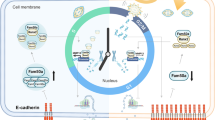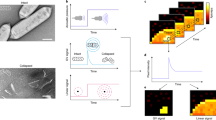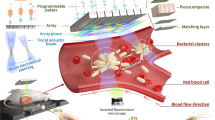Abstract
We report a non-viral gene transfer method using ultrasound induced microbubble destruction to allow the uptake of plasmid gene transfer vectors to the cells of the mouse salivary gland. The Luciferase (Luc) reporter gene, driven by a cytomegalovirus (CMV) promoter, was delivered unilaterally to the submandibular salivary gland via retroductal cannulation and Luc expression was monitored with in vivo imaging. The CMV-Luc plasmid was delivered to the salivary gland in a carrier solution containing microbubbles composed of lipid-encased perfluoropropane gas, with two different concentrations of microbubbles used (100 and 15% volume/volume). An Adenoviral (Ad) vector using an identical CMV-Luc expression cassette was used as a positive control at two different dosages. Whereas ultrasound-assisted gene transfer (UAGT) with 100% microbubbles was weak and rapidly extinguished, UAGT with the 15% microbubble solution was robust and stable for 28 days. UAGT seems to be a practicable and promising method for non-viral gene delivery to the salivary glands.
This is a preview of subscription content, access via your institution
Access options
Subscribe to this journal
Receive 12 print issues and online access
$259.00 per year
only $21.58 per issue
Buy this article
- Purchase on Springer Link
- Instant access to full article PDF
Prices may be subject to local taxes which are calculated during checkout





Similar content being viewed by others
References
Wang J, Voutetakis A, Zheng C, Baum BJ . Rapamycin control of exocrine protein levels in saliva after adenoviral vector-mediated gene transfer. Gene Ther 2004; 11: 729–733.
Cotrim AP, Mineshiba F, Sugito T, Samuni Y, Baum BJ . Salivary gland gene therapy. Dent Clin North Am 2006; 50: 157–173, vii.
Mastrangeli A, O'Connell B, Aladib W, Fox PC, Baum BJ, Crystal RG . Direct in vivo adenovirus-mediated gene transfer to salivary glands. Am J Physiol 1994; 266: G1146–G1155.
Voutetakis A, Kok MR, Zheng C, Bossis I, Wang J, Cotrim AP et al. Reengineered salivary glands are stable endogenous bioreactors for systemic gene therapeutics. Proc Natl Acad Sci USA 2004; 101: 3053–3058.
National Institute of Dental and Craniofacial Research, Open-label, dose-escalation study evaluating the safety of a single administration of an adenoviral vector encoding human aquaporin-1 to one parotid salivary gland in individuals with irradiation-induced parotid salivary hypofunction. NIH study # 06-D-0206, FDA IND # 13102.
Baum BJ, Zheng C, Alevizos I, Cotrim AP, Liu S, McCullagh L et al. Development of a gene transfer-based treatment for radiation-induced salivary hypofunction. Oral Oncol 2009; 46: 4–8.
Young LS, Searle PF, Onion D, Mautner V . Viral gene therapy strategies: from basic science to clinical application. J Pathol 2006; 208: 299–318.
Descamps D, Benihoud K . Two key challenges for effective adenovirus-mediated liver gene therapy: innate immune responses and hepatocyte-specific transduction. Curr Gene Ther 2009; 9: 115–127.
Bangari DS, Mittal SK . Current strategies and future directions for eluding adenoviral vector immunity. Curr Gene Ther 2006; 6: 215–226.
Kok MR, Voutetakis A, Yamano S, Wang J, Cotrim A, Katano H et al. Immune responses following salivary gland administration of recombinant adeno-associated virus serotype 2 vectors. J Gene Med 2005; 7: 432–441.
Nair V . Retrovirus-induced oncogenesis and safety of retroviral vectors. Curr Opin Mol Ther 2008; 10: 431–438.
Yi Y, Hahm SH, Lee KH . Retroviral gene therapy: safety issues and possible solutions. Curr Gene Ther 2005; 5: 25–35.
Suda T, Liu D . Hydrodynamic gene delivery: its principles and applications. Mol Ther 2007; 15: 2063–2069.
Dean DA, Machado-Aranda D, Blair-Parks K, Yeldandi AV, Young JL . Electroporation as a method for high-level nonviral gene transfer to the lung. Gene Ther 2003; 10: 1608–1615.
Somiari S, Glasspool-Malone J, Drabick JJ, Gilbert RA, Heller R, Jaroszeski MJ et al. Theory and in vivo application of electroporative gene delivery. Mol Ther 2000; 2: 178–187.
Martin JB, Young JL, Benoit JN, Dean DA . Gene transfer to intact mesenteric arteries by electroporation. J Vasc Res 2000; 37: 372–380.
Miller DL, Pislaru SV, Greenleaf JE . Sonoporation: mechanical DNA delivery by ultrasonic cavitation. Somat Cell Mol Genet 2002; 27: 115–134.
Taniyama Y, Tachibana K, Hiraoka K, Aoki M, Yamamoto S, Matsumoto K et al. Development of safe and efficient novel nonviral gene transfer using ultrasound: enhancement of transfection efficiency of naked plasmid DNA in skeletal muscle. Gene Ther 2002; 9: 372–380.
Taniyama Y, Tachibana K, Hiraoka K, Namba T, Yamasaki K, Hashiya N et al. Local delivery of plasmid DNA into rat carotid artery using ultrasound. Circulation 2002; 105: 1233–1239.
Voutetakis A, Bossis I, Kok MR, Zhang W, Wang J, Cotrim AP et al. Salivary glands as a potential gene transfer target for gene therapeutics of some monogenetic endocrine disorders. J Endocrinol 2005; 185: 363–372.
Nowroozi N, Denny PA, Denny PC, Zernik JH . Two gene products for beta-galactosidase are differentially expressed in the mouse salivary glands. J Craniofac Genet Dev Biol 1998; 18: 51–57.
Green M, Sviland L, Taylor CE, Peiris M, McCarthy AL, Pearson AD et al. Human herpes virus 6 and endogenous biotin in salivary glands. J Clin Pathol 1992; 45: 788–790.
Zheng C, Goldsmith CM, Mineshiba F, Chiorini JA, Kerr A, Wenk ML et al. Toxicity and biodistribution of a first-generation recombinant adenoviral vector, encoding aquaporin-1, after retroductal delivery to a single rat submandibular gland. Hum Gene Ther 2006; 17: 1122–1133.
Isacsson G, Ahlner B, Lundquist PG . Chronic sialadenitis of the submandibular gland. A retrospective study of 108 case. Arch Otorhinolaryngol 1981; 232: 91–100.
Takahashi M, Kido K, Aoi A, Furukawa H, Ono M, Kodama T . Spinal gene transfer using ultrasound and microbubbles. J Control Release 2007; 117: 267–272.
Guo H, Leung JC, Chan LY, Tsang AW, Lam MF, Lan HY et al. Ultrasound-contrast agent mediated naked gene delivery in the peritoneal cavity of adult rat. Gene Ther 2007; 14: 1712–1720.
Bekeredjian R, Chen S, Frenkel PA, Grayburn PA, Shohet RV . Ultrasound-targeted microbubble destruction can repeatedly direct highly specific plasmid expression to the heart. Circulation 2003; 108: 1022–1026.
Chen S, Ding JH, Bekeredjian R, Yang BZ, Shohet RV, Johnston SA et al. Efficient gene delivery to pancreatic islets with ultrasonic microbubble destruction technology. Proc Natl Acad Sci USA 2006; 103: 8469–8474.
Wang S, Baum BJ, Yamano S, Mankani MH, Sun D, Jonsson M et al. Adenoviral-mediated gene transfer to mouse salivary glands. J Dent Res 2000; 79: 701–708.
Elmore S, Lanning L, Allison N, Vallant M, Nyska A . The transduction of rat submandibular glands by an adenoviral vector carrying the human growth hormone gene is associated with limited and reversible changes at the infusion site. Toxicol Pathol 2006; 34: 385–392.
Yoon CS, Jung HS, Kim TK, Kwon MJ, Kim MK, Lee M et al. Comparison of the efficiency and toxicity of sonoporation with branched polyethylenimine-mediated gene transfection in various cultured cell lines. J Drug Target 2008; 16: 773–779.
Hodges BL, Taylor KM, Joseph MF, Bourgeois SA, Scheule RK . Long-term transgene expression from plasmid DNA gene therapy vectors is negatively affected by CpG dinucleotides. Mol Ther 2004; 10: 269–278.
Chen ZY, He CY, Ehrhardt A, Kay MA . Minicircle DNA vectors devoid of bacterial DNA result in persistent and high-level transgene expression in vivo. Mol Ther 2003; 8: 495–500.
Chen ZY, He CY, Kay MA . Improved production and purification of minicircle DNA vector free of plasmid bacterial sequences and capable of persistent transgene expression in vivo. Hum Gene Ther 2005; 16: 126–131.
Acknowledgements
We thank the National Institutes of Health (5R00DE018188-03 to MJP) and the Allegheny Heart Institute for financial support, VisualSonics Inc. for providing the SoniGene device and Dennis Trumble for technical assistance with ultrasonography.
Author information
Authors and Affiliations
Corresponding author
Ethics declarations
Competing interests
The authors declare no conflict of interest.
Rights and permissions
About this article
Cite this article
Passineau, M., Zourelias, L., Machen, L. et al. Ultrasound-assisted non-viral gene transfer to the salivary glands. Gene Ther 17, 1318–1324 (2010). https://doi.org/10.1038/gt.2010.86
Received:
Revised:
Accepted:
Published:
Issue Date:
DOI: https://doi.org/10.1038/gt.2010.86
Keywords
This article is cited by
-
Tetravalent dengue DNA vaccine is not immunogenic when delivered by retrograde infusion into salivary glands
Tropical Diseases, Travel Medicine and Vaccines (2020)
-
IL-17 sequestration via salivary gland gene therapy in a mouse model of Sjogren’s syndrome suppresses disease-associated expression of the putative autoantigen Klk1b22
Arthritis Research & Therapy (2015)
-
Ultrasound-assisted nonviral gene transfer of AQP1 to the irradiated minipig parotid gland restores fluid secretion
Gene Therapy (2015)
-
Proteomic profiling of salivary gland after nonviral gene transfer mediated by conventional plasmids and minicircles
Molecular Therapy - Methods & Clinical Development (2014)
-
Plasmid DNA is internalized from the apical plasma membrane of the salivary gland epithelium in live animals
Histochemistry and Cell Biology (2012)



